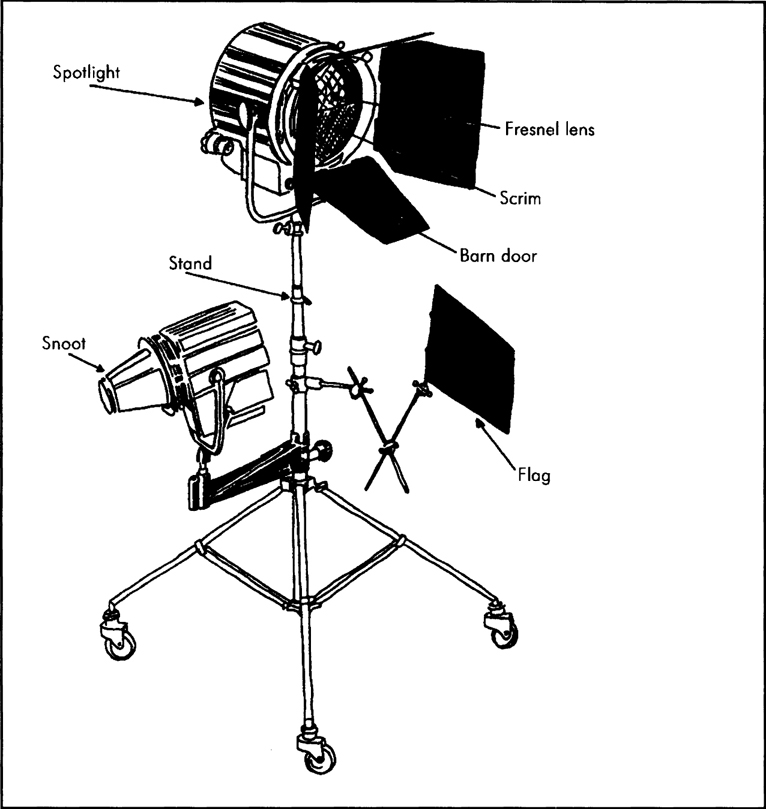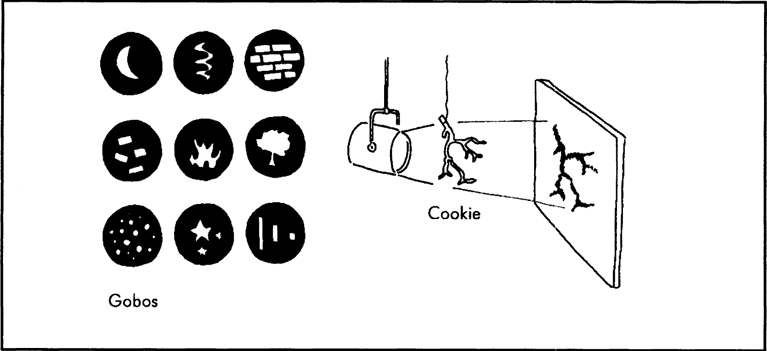6 Lighting accessories
With manufacturers offering a vast range of luminaires, it is always possible to find ‘the light for the job’. What is not so easy is to find a luminaire that will do that job as precisely as we need it to. Part of the art of the lighting team is to find ways of controlling the beam width, size, shape, colour and intensity to make a video picture look right.
To do this we need to employ some of the accessories that are produced to refine and customize a luminaire, so that it provides exactly the desired effect. Here we will just look at brief descriptions of the accessories available and consider the effects of fitting them to luminaires.
Accessories
Barn doors
Barn doors offer a method of restricting the beam size from luminaires. They are normally fitted to spotlights, but can be fitted to small floodlights.
Barn doors consist of a frame of four metal flaps, of which two are larger than the other two. The whole frame is inserted into a special mount at the front of the luminaire and can be rotated.
Tilting the flaps up or down (or in and out for the sideways pair) will restrict the light beam into an envelope shape of variable size. Because barn doors can be rotated they form an easy way of shaping a beam to ‘fit’ a particular area of the scene.
They must be safety clipped to the luminaire to prevent them falling off, and should be checked regularly to see that the hinges are still tight enough to prevent them dropping with their own weight. This can be a particularly noticeable problem when they get hot.
Figure 6.1 Complete range of accessories

Snoots
Snoots are similar in principle to barn doors, in that they shape the light beam, but are pre-formed cones, of various fixed sizes. Snoots are fitted to spotlights to restrict the diameter of the beam.
Whereas barn doors give an envelope shaped beam, the snoot will allow you to provide small circles of light to highlight individual areas that are smaller than the spotlight’s normal pattern. If the luminaire to background angle is reduced, it is possible to produce an ellipse-shaped beam.
Again they are fitted to the front of the luminaire and must be safety clipped, to prevent them falling off.
Flags
Flags are small opaque panels (20 cm x 30 cm is a common size, but they can be smaller or slightly larger) of thin metal, or may be large textile panels mounted in front of a luminaire. They are fitted to a short extension tube connected to a tripod on location or clipped onto the housing of the luminaire in the studio. Flags are designed to restrict part of the light beam.
Flags will produce a much sharper shadow than barn doors and are often used to prevent light falling onto a particular object within the scene. A common problem with lighting is how to deal with a light that is in shot. Flags can be used to mask the light that is falling on the camera lens, or larger sheets of opaque cloth can be hung in front of the light (beware of heat causing fire!) to mask out a light shining from the darker parts of the scene.
For some rather unfortunate and confusing reason, flags are known in some countries as gobos. It is wiser to think of them as flags to avoid confusion with the gobos we will discuss later.
Scrims
The joys of learning a new technical language are often marred by one word meaning two totally different things! ‘Scrim’ is one of these words. If you want an accurate definition of a scrim it is either ‘a metal screen placed in the front of a luminaire to reduce its intensity without altering colour temperature’, or ‘a screen, placed in front of a luminaire to act as a diffuser and often decrease the light output’.
The important thing is that, whatever else it might do, a scrim will alter the intensity of a luminaire. Scrims are placed in a holder fitted to the front of the luminaire or to a holder on barn doors or snoots. They are made of metal mesh because they are close to the source of the light and so they will get very hot.
The most effective way of reducing a luminaire’s intensity is to move it further away from the scene. This doesn’t affect the colour temperature (as dimming does) and any increased light spill can be contained with barn doors. On location this may not be possible because, particularly indoors, the space may not permit the luminaire to be placed exactly where you want it. This makes scrims essential to a proper lighting balance on location.
It is possible to get full-frame scrims, which will cut down the total intensity, half-frame scrims, allowing only half of the beam to be cut (these will rotate so you can choose which half), or graduated scrims, which also rotate, but allow a graded reduction in intensity from top to bottom.
If the scrim is required to diffuse the light, as well as reducing its intensity, then frosted sheets of plastic or glass fibre are placed in front of the luminaire. These must be clipped a short distance from the luminaire because otherwise the increased heat and restricted air flow can shorten the bulb life considerably.
If you have a scrim and don’t know whether it diffuses as well as cutting the intensity, a handy hint is to hold it up and look at the scene through it. If you see a clear image it will not diffuse the light.
Colours and shapes
Once we have chosen the most suitable luminaire, and adjusted its beam width, angle and shape, the next consideration is the colour of the light.
Manufacturers offer a large range of coloured gels (normally just called ‘gels’, originating from gelatine, the material that they used to be made from). There are well over 100 colours to choose from, some are hard solid colour, others are more subtle pastel colours used for shading. It is usual to keep around fifteen to twenty of the most often used colours in stock, but lighting directors are notorious for wanting ones that are slightly different to the more common ones for their special programme!
Gels come in rolls and are cut to fit into a special ‘gel frame’ that slips into a slot in front of the luminaire. They can be used in addition to barn doors, flags and other accessories. All will reduce the intensity of the light. The material used and the use it is put to will determine its useful life. Eventually the heat will cause discoloration and the gel will need replacing.
Apart from gels designed to colour a light, a complete range of gels are available for colour temperature correction. These are normally used to convert tungsten to daylight or vice versa, but it is possible to get conversion filters that are used to balance lights. Where a dimmer is used to reduce the output of a particular luminaire considerably more than the overall rig, for instance, just one light may need a slight colour temperature correction.
Fluorescent lighting, carbon arc and compact source lighting do not match the standard daylight, or tungsten, colour temperature and need to be corrected. Special glass dichroic filters are made to fit small focusing reflector luminaires, such as the Redhead range, to convert them to daylight. They are quicker to fit than gel materials.
We have said that the best way of reducing the total light intensity is to alter the light-to-subject distance and where this isn’t possible we suggested the use of scrims. Neutral density gels offer a third alternative. These do not diffuse the light or affect the colour temperature, but will reduce the intensity by known amounts. A 0.3ND, for instance reduces the light by one f-stop, a 0.6ND by two f-stops.
Combination filters are made which will convert daylight to tungsten and reduce the intensity, these are useful for interior tungsten shooting. If hung as sheets in front of a bright sunlit window it is possible to balance the light intensity and correct the colour temperature at the same time.
To complete the list of available gels, there is a range of frosts which will diffuse light, soften light and even diffuse and correct the colour temperature. Special gels will soften and tint cyc lighting, absorb ultraviolet light, or can be used to bounce light off to soften, harden or warm the overall effect. Perhaps the suggestion that fifteen to twenty need to be kept in stock now looks a little mean!
While we are looking at colours it is worth mentioning that some luminaires will accept colour wheels, or scrollers. These are motorized units which fit onto the front of the luminaire and allow a range of colours to be either scrolled through’ at a predetermined speed, or different colours to be selected, and held, with the colour wheel movement controlled from the lighting desk as a cue.
Special luminaires, called ‘effects projectors’, are sometimes used in this way with special attachments to project cloud, fire or rain effects.
Two other methods are commonly used to produce specific effects, the cukaloris and the gobo. The cukaloris is commonly called a ‘cookie’ and is no more than a shaped piece of metal or wood that is hung in front of a luminaire. This shape, placed in the light beam, will cast a shadow in the scene. Typically they could produce shadows of trees, branches, prison bars, venetian blinds or people. Anywhere that you need a soft focused shadow all you need to do is remember how it happens in real life. Perhaps sunlight filtering through a tree will throw a shadow of the tree inside a room. A cookie in the shape of a branch placed in front of a luminaire will do the same thing. A cookie is something you make, don’t go out and buy it.
Figure 6.2 Gobos, cookie

You may remember that when we talked about the profile, or ellipsoidal, spotlight we said that it had a gate, into which we could place slides that could be focused on the background. Metal shapes can be cut and placed in this gate. These are called gobos. We referred to the difficulties of one word meaning two things when we looked at scrims, here is another example. Some countries refer to flags as gobos, but all countries refer to the piece of metal placed in the gate of a profile spot as gobos, except the USA where they are called ‘patterns’.
Gobos are used in the same way as cookies, in that they are designed to produce shapes and patterns on the background. The difference between the two is that the gobo is normally used to focus the shape onto the background. Rather than casting a shadow, it projects it.
Gobos are very useful in providing specific patterns on backgrounds and are almost always made by the lighting team from a metal stencil. Some are available, in heart or keyhole shapes for instance, but the pattern required to be projected onto the background is really programme specific, necessitating its manufacture.
